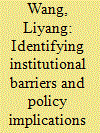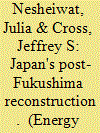| Srl | Item |
| 1 |
ID:
175248


|
|
|
|
|
| Summary/Abstract |
Large organizations wield considerable market power, their procurement activities can be leveraged to achieve social, economic and environmental goals by ‘pulling’ more desirable products into the market. However, while there is substantial research in individual consumer buying behavior and market barriers to sustainable technology adoption, less is known about large organizational buying behavior and the impact of institutional barriers in this area. To address these research gaps, we conducted an exploratory study aimed at better understanding the process through which large organizations purchase sustainable energy technologies and what internal barriers they experience during that process. We surveyed and interviewed 120 individuals involved in procurement from Californian organizations representing both public and private sectors. Survey results indicate the need to resolve the conflict between prioritizing lowest first cost and lowest life cycle cost, better engage multiple stakeholders involved in internal decision-making around purchasing, and improve existing procurement tools or offer new ones. We provide recommendations for how policymakers can apply our findings to increase the adoption of sustainable energy technologies in their own organizations and communities.
|
|
|
|
|
|
|
|
|
|
|
|
|
|
|
|
| 2 |
ID:
124392


|
|
|
|
|
| Publication |
2013.
|
| Summary/Abstract |
Following World War II, Japan miraculously developed into an economic powerhouse and a model of energy efficiency among developed countries. This lasted more than 65 years until the Northeastern Japan earthquake and tsunami induced nuclear crisis of March 2011 brought Japan to an existential crossroads. Instead of implementing its plans to increase nuclear power generation capacity from thirty percent to fifty percent, Japan shut-down all fifty-four nuclear reactors for safety checks and stress-checks (two have since been restarted), resulting in reduced power generation during the summer of 2012. The reconstruction of Northeastern Japan approaches at a time when the world is grappling with a transition to sustainable energy technologies-one that will require substantial investment but one that would result in fundamental changes in infrastructure and energy efficiency.
Certain reconstruction methods can be inappropriate in the social, cultural and climatic context of disaster affected areas. Thus, how can practitioners employ sustainable reconstructions which better respond to local housing needs and availability of natural energy resources without a framework in place? This paper aims at sensitizing policy-makers and stakeholders involved in post disaster reconstruction by recognizing advantages of deploying sustainable energy technologies, to reduce dependence of vulnerable communities on external markets.
|
|
|
|
|
|
|
|
|
|
|
|
|
|
|
|